Startup Funding Espresso Second-Order Thinking

Second-Order Thinking Hello, this is Hall T. Martin with the Startup Funding Espresso -- your daily shot of startup funding and investing. First-order thinking looks at solving the immediate problem. Second-order thinking looks at the consequences of solving the problem. To practice second-order thinking, ask the question, \u201cand then what?\u201d Most people look at the world through first-order thinking such as \u201cThat product is on sale, I should buy it.\u201d Second-order thinking asks the question, "then what?" \u201cIf I buy the product then I\u2019ll need to use it.\xa0 I really don\u2019t have a use for it, therefore, I shouldn\u2019t buy it.\u201d In ideating on a startup problem, move beyond first-order thinking to second-order thinking. Given a customer problem, what are the implications of solving it in a few days, a few months, and a few years? How will the market respond to the problem? What will competitors do? How important is this problem to the customer? How else will the customer respond to the problem? First-order thinking is simple and straightforward. Second-order thinking is complex and complicated. Consider applying second-order thinking to the customer problem your company solves. \xa0 Thank you for joining us for the Startup Funding Espresso where we help startups and investors connect for funding.Let\u2019s go startup something today. _______________________________________________________ For more episodes from Investor Connect, please visit the site at: \xa0 Check out our other podcasts here: \xa0 For Investors check out: \xa0 For Startups check out: \xa0 For eGuides check out: \xa0 For upcoming Events, check out \xa0\xa0 For Feedback please contact info@tencapital.group\xa0\xa0\xa0 Please , share, and leave a review. Music courtesy of .